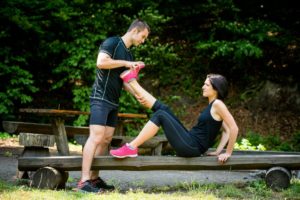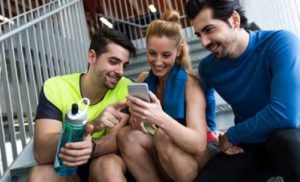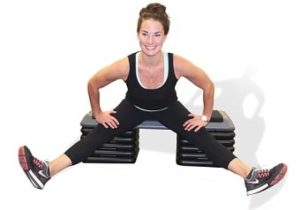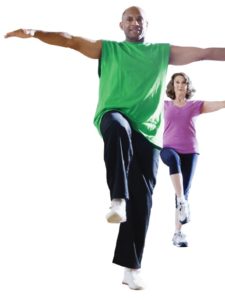Warm Ups/Cool Downs
Learn, Connect and Thrive at the IDEA® World Convention
Education is the foundation of the IDEA World Convention, but this fitness event offers plenty more than stellar instruction. For Jonathan Bernath, publicist-turned-personal-trainer, it’s where he discovered the “fitness family” that would guide him in his new career.
The Achilles Tendon
Many fitness professionals have dealt with an Achilles tendon injury, either their own or a client’s. The largest and strongest tendon in the body, the Achilles connects the lower-leg muscles and calf to the heel. “Synchronous functioning” of the tendon and calf is crucial for many activities, including standing on tiptoe, running, jumping and climbing stairs (Bhimji 2016).
Dutch surgeon Philip Verheyen named the tendon (after the Greek hero Achilles) in 1693. Previously, it was known as “tendo magnus of Hippocrates” (van Dijk 2011).
Cultivate Joy Through Mindfulness
It’s a busy, technology-dominated world—and most of us are continually spinning, twisting and turning in an effort to “get things done” and “produce.” We work, we raise families, we have countless responsibilities. The truth is, this is distracted living, and it raises stress levels, lowers productivity and interferes with our ability to focus. When we live this way, we fail to cultivate a sense of contentment and joy.
Cultivating a Home Yoga Practice
Find out why a home yoga practice can benefit your students, how to encourage them to create the space, and what will help them sustain it.
Hit the Hips!
Eager class participants want to tap into their highest potential, and group fitness instructors have been acknowledging this by offering workouts that are more explosive, more powerful and fuller in range than ever before. However, intense, dynamic workouts demand a warmup that truly prepares the body. Specifically, you must target the hips—hip flexors, piriformis, glutes and hip rotators—to avoid possible tweaks from all those lunges, squats and burpees (not to mention repetitive stress from cycling and running).
How to Handle Exercise-Related Muscle Cramps
You’re running along your favorite path and then it happens: You get a cramp in your hamstring. While theories abound, there is limited consensus on why exercise-associated muscle cramps (EAMC) develop and how to get rid of them. A research review from the Brooks College of Health at the University of North Florida may clear up the confusion.
The review, published in Muscle & Nerve (2016; 54, 177–85), featured a series of studies analyzing the etiology and treatment of EAMC. Here’s what they learned:
Tai Chi: The Perfect Balance for Aging Adults
Why tai chi?
These Chinese movement patterns have been around for centuries. In recent years, study after study has proven the benefits of tai chi—particularly for older exercisers—yet most fitness professionals seem to know little about it.
That’s too bad, because just about any fitness client can learn tai chi, and any fitness professional can teach it. Like other types of exercise, tai chi simply requires you to learn its movements and experience its benefits.
Why Proper Rib-Cage Position Is Important
Proper thoracic-cage functioning sets the groundwork for healthy movement.
The Poetry of Yoga
Some 80 million Americans were expected to try yoga last year, according to the 2016 Yoga in America Study (Yoga Journal & Yoga Alliance 2016). Couple this statistic with the continuing effort to entice baby boomers with new and effective movement class designs, and you get a sense of the opportunity yoga provides for dedicated teachers with skill and creativity.
A Yoga-Based Finish
Sun salutations integrate strength, endurance, flexibility, controlled breathing and mindfulness. This cycle of postures is traditionally used in many yoga classes to warm up the body, as the sequence addresses all major joints and muscle groups while increasing blood flow and circulation. However, it also helps to release stress on the spine and promote relaxation, a perfect combination for a cool–down!
3 Steps to Help Clients Unplug
Use the warmup to create a bridge from digital distraction to full, present engagement.
Training the Pelvic Core
"I wish someone had told me this could happen to my body after having a baby!" . . . "Why did my doctor tell me I could return to exercise at my 6–week checkup?"
Sample Class: Body-Weight Barrage
When was the last time you taught a class based solely on using the body as a "machine"? Body–weight exercises are often undervalued and underused. Many people want to advance rapidly, and they end up neglecting important functional (and foundational) movement patterns. Body–Weight Barrage blends popular strength training moves with cutting–edge training methods in a way that challenges clients at any fitness level without using barbells, dumbbells or any other equipment.
Flexibility Plus
Stretching has become a controversial topic, and some research questions its efficacy. You may have wondered whether you should include stretches in your cooldowns. As a general rule of thumb, if it's weak, strengthen it; if it's sore, rub it; if it's locked, unlock it; and if it's tight, stretch it. This works in theory, but we don't know exactly what's going on with our participants' bodies. What we do know is that most people want to move more freely and with less pain.
The 4 Most Common Running Injuries and How to Address Them
Use corrective exercise to help clients stay on track with their mileage goals.
Yoga and Tai Chi Offer Nondrug Pain Management
Complementary approaches like yoga, tai chi, acupuncture, massage therapy and relaxation techniques can help some people manage chronic pain, says a research review published in Mayo Clinic Proceedings (2016; 91 [9], 1292–1306). In the United States, chronic pain affects 126 million adults in any given year, with as many as 40 million of them suffering from severe pain. Leading disorders include back pain, joint pain, neck pain and headaches.
Power Up to Prevent Injury
Participants rarely think about injuries until after they happen (hopefully not in your class!). But someone who needs rehabilitation may face a delay in meeting fitness goals. Another issue: Our group fitness studios are filling with people of many different ages and abilities.
Menopause Symptoms: Can Yoga Help?
"Joanne," aged 51, presents with hot flashes and vaginal atrophy. She feels depressed, anxious, irritable, fatigued and not as confident in herself as she once was. Somehow she feels out of control. Her body is behaving unpredictably: She doesn't know when her next hot flash is coming or how to control the fat that is shifting up toward her waist.
“Do your clients perform stretches before a workout, or do they do a dynamic warm-up and then static stretching at the end?”
We do a dynamic warm-up to raise body temperature, which raises heart rate and increases circulation to muscles, tendons and ligaments. A dynamic warm-up also helps prepare the mind and body for the upcoming workout, enhances performance and reduces injuries.
I even use dynamic warm-ups when I teach yoga. Most Baby Boomers (and I am one of them) need dynamic warm-ups.
Help Students With “Tech Neck”
Have you noticed an increase in postural deviations among your students? In today’s society, “tech neck” is becoming more common—we all spend too much time looking down at our devices. This requires rounding the shoulders (rather than keeping them back and down, with chest open) and jutting the head forward. The position is becoming so habitual for a lot of people that it feels fixed and “natural” to them. Help participants become more aware of this uncomfortable trend and empower them to make better choices.


















